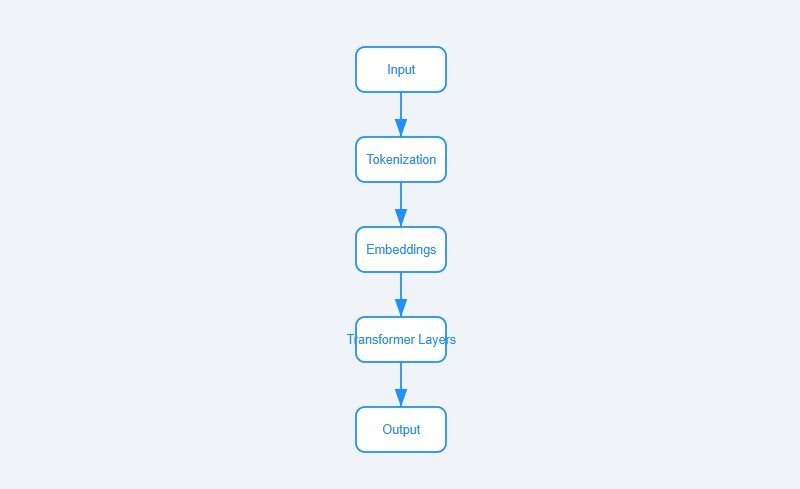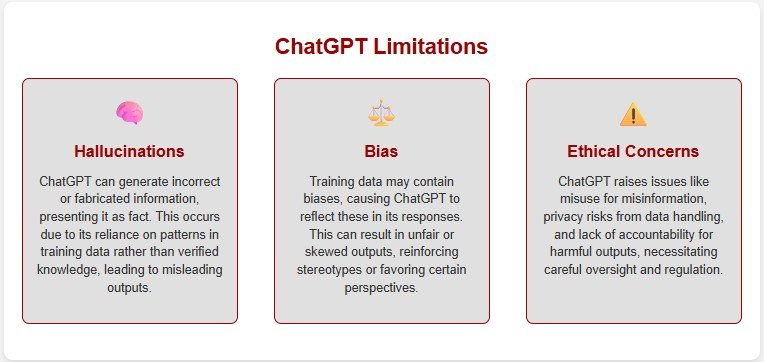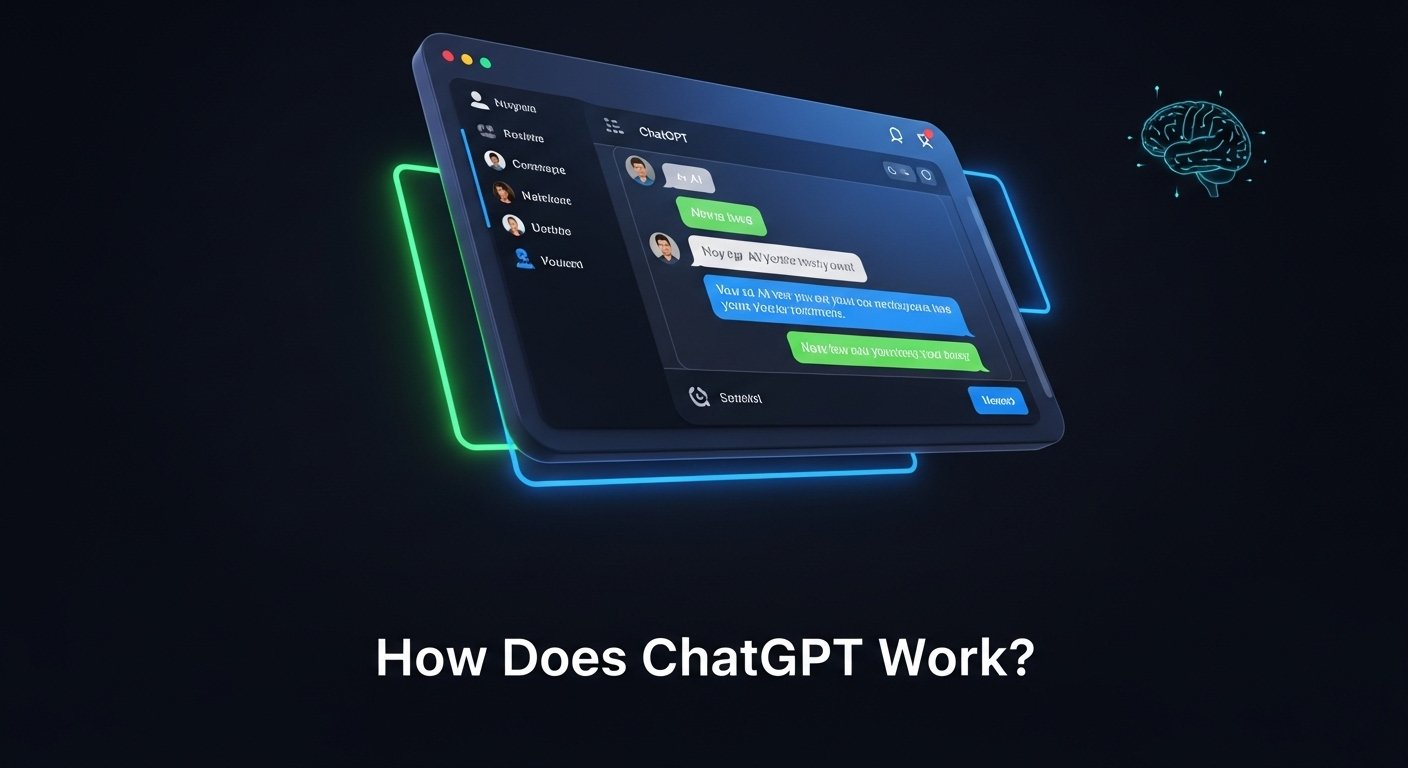ChatGPT is an AI chatbot developed by OpenAI. Launched on November 30, 2022, it has grown to nearly 800 million weekly users by August 2025. It generates human-like text, answers questions, writes code, translates languages, and more. Its rise sparked the AI boom, but it also raised concerns about accuracy, ethics, and privacy, like Italy’s brief ban in 2023. This guide explains how ChatGPT works, its capabilities, limitations, applications, and future in simple terms.

How ChatGPT Works
ChatGPT uses a large language model (LLM) called the Generative Pre-trained Transformer (GPT). Trained on billions of words from the internet, it learns language patterns to respond to user prompts.
Core Technology
ChatGPT’s process involves several steps:
- Tokenization: Breaks your input into small units called tokens, like words or punctuation.
- Embeddings: Turns tokens into numbers to capture their meaning and context.
- Transformer Architecture: Processes tokens through layers (e.g., 96 in GPT-3) to understand relationships and generate responses.
- Prediction: Outputs the next likely word, building a coherent reply.
This happens in milliseconds, making conversations feel natural.
Training Process
ChatGPT is trained using:
- Supervised Learning: Matches inputs to correct outputs using human-labeled data.
- Reinforcement Learning from Human Feedback (RLHF): Humans rank responses to improve accuracy. For example, Kenyan workers earned $1.32–$2/hour to review content, sometimes facing harmful material.
It uses 200–300 billion words from sources like Wikipedia and books. This vast data helps it answer diverse questions but can introduce biases.

Multimodal Features
ChatGPT handles text, images, and audio. It can describe images, transcribe voice notes, or generate art via DALL·E. Plugins, like Zapier, let it connect to apps for tasks like scheduling. Developers can use the ChatGPT API to build custom tools.
What Can ChatGPT Do?
ChatGPT is versatile and used across industries. Its key capabilities include:
- Answering questions on history, science, or trivia
- Writing essays, stories, or social media posts
- Coding and debugging in Python, JavaScript, and more
- Translating languages like Spanish or Mandarin
- Summarizing articles or research papers
- Creating lists for chores or planning
Real-World Examples
- Education: Helps students with homework or creates lesson plans. Learn more in our post on ChatGPT for UX Research.
- Business: Automates customer service or drafts reports. See ChatGPT in Procurement.
- Tech: Generates code, though 52% of its Stack Overflow answers had errors in 2023.
- Creative Work: Writes stories or generates art prompts. Check out ChatGPT’s Creative Capabilities.
It processes over 1 billion queries daily, showing its wide reach.
Limitations of ChatGPT
ChatGPT isn’t perfect. Its main limitations are:
- Hallucinations: Gives plausible but wrong answers (3% rate in 2023).
- Bias: Reflects biases in its training data, like cultural stereotypes.
- No Deep Understanding: Relies on patterns, not true reasoning, missing sarcasm or nuance.
- Ethical Issues: Risks include cheating, misinformation, or job loss. Schools banned it in 2023 over plagiarism fears.
- Privacy: Collects user data, leading to Italy’s ban in March 2023, lifted in April after fixes.
- Resource Use: Needs 30,000 GPUs, using 0.5 liters of water per 5–50 prompts.
Always verify its outputs for accuracy.

Applications Across Industries
ChatGPT serves many fields:
- Education: Assists with assignments but faces cheating concerns.
- Business: Boosts efficiency with tools like ChatGPT for Sales.
- Healthcare: Passes medical exams but isn’t a doctor replacement.
- Law: Drafts legal documents, though it’s produced fake citations (e.g., Mata v. Avianca, Inc., 2023).
- Finance: Outperformed funds with a 4.9% stock portfolio gain in 2023.
Its flexibility makes it a powerful tool, but users must address its flaws.
Future of ChatGPT
As of August 2025, ChatGPT is evolving fast:
- Memory: Recalls past chats for better responses (opt-in for free users).
- Deep Research: Integrates with Dropbox for reports in 5–30 minutes.
- GPT-4o: Updated in March 2025, it’s better at coding and creativity.
- Agent Mode: Launched in July 2025, it books flights or orders food.
- GPT-5: Expected in summer 2025, aiming for “unified intelligence.”
- GPT Store: Hosts 3 million custom GPTs since January 2024.
OpenAI projects $11 billion in revenue by 2025, with 800 million weekly users. Ethical and environmental challenges persist.
Conclusion
ChatGPT is a powerful AI tool that uses advanced language models to answer questions, write code, and more. Its transformer architecture and vast training data enable human-like responses, but it can make errors, reflect biases, and raise ethical concerns. With updates like GPT-5 and agent mode, it’s set to become even more useful. Always check its outputs and use it responsibly. Want to learn more? Read our post on ChatGPT vs. Traditional Search Engines.
